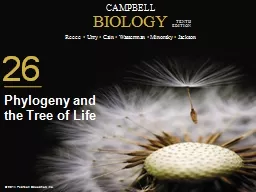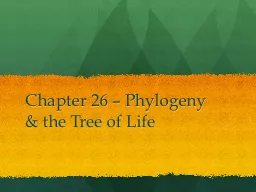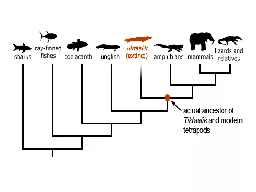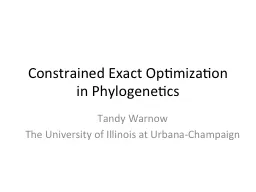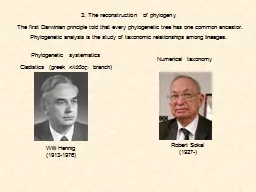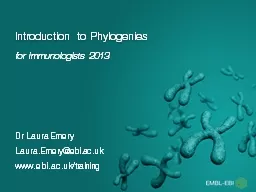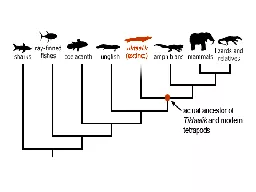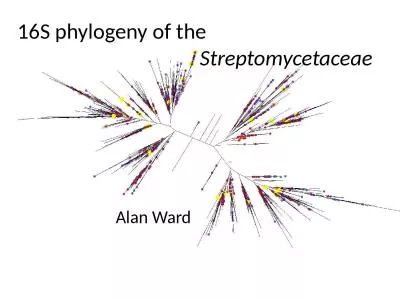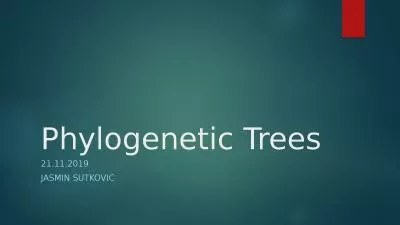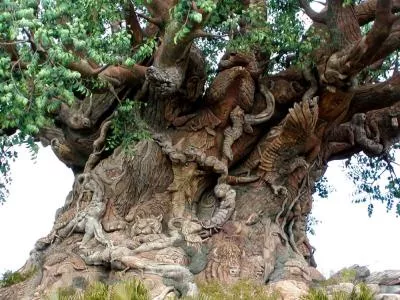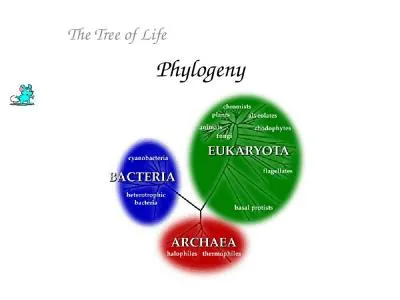PPT-26 Phylogeny and the Tree of Life
Author : tatiana-dople | Published Date : 2016-11-13
Investigating the Tree of Life Legless lizards have evolved independently in several different groups Figure 261 Phylogeny is the evolutionary history of a species
Presentation Embed Code
Download Presentation
Download Presentation The PPT/PDF document "26 Phylogeny and the Tree of Life" is the property of its rightful owner. Permission is granted to download and print the materials on this website for personal, non-commercial use only, and to display it on your personal computer provided you do not modify the materials and that you retain all copyright notices contained in the materials. By downloading content from our website, you accept the terms of this agreement.
26 Phylogeny and the Tree of Life: Transcript
Investigating the Tree of Life Legless lizards have evolved independently in several different groups Figure 261 Phylogeny is the evolutionary history of a species or group of related species For example a phylogeny shows that legless lizards and snakes evolved from different lineages of legged lizards. - based on whole genome data. Johanne Ahrenfeldt . Research Assistant. Overview. What is Phylogeny and what can it be used for. S. ingle . N. ucleotide . P. olymorphism (SNP) methods. - . snpTree. . 26.1. Phylogeny. Evolutionary history of a species or a group of related species. Made by using evidence from systematics. Focuses on classifying organisms & relationships. Uses fossils, morphology, genes, & molecular evidence. http://thumbnails.visually.netdna-cdn.com/the-great-tree-of-life_505ba0c07cda2.gif. Figure 26.1 Some major episodes in the history of life. Figure 26.15 Whittaker’s five-kingdom system. Figure 26.16 Our changing view of biological diversity. Tandy Warnow. The University of Illinois at Urbana-Champaign. Brief history. We met in 1992, when I was working in the Discrete Algorithms Group at Sandia National Labs.. I moved to the University of Pennsylvania in 1993, then to the University of Texas at Austin in 1999. No papers yet. Tandy Warnow. The University of Illinois at Urbana-Champaign. Orangutan. Gorilla. Chimpanzee. Human. From the Tree of the Life Website,. University of Arizona. Phylogeny. (evolutionary tree). DNA Sequence Evolution. Objective. SWBAT explain and demonstrate that organisms share many conserved core processes and features that evolved and are widely distributed among organisms today.. Agenda. Chapter 25 Quiz. Chapter 26 notes: sections 26.1, 26.2, and 26.3. The first Darwinian principle told that every phylogenetic tree has one common ancestor. .. Phylogen. e. tic analysis is the study of taxonomic relationships among lineages. .. Willi Hennig . (1913-1976). Phylogenies. Dr Laura Emery . Laura.Emery@ebi.ac.uk. www.ebi.ac.uk. /training. Objectives. After this tutorial you should be able to…. Use essential phylogenetic . terminology . effectively. Discuss aspects of phylogenies and their implications for phylogenetic . Figure 26.1 Some major episodes in the history of life. Figure 26.15 Whittaker’s five-kingdom system. Figure 26.16 Our changing view of biological diversity. Figure 27.2 The three domains of life. . Streptomycetaceae. Alan Ward. Motivation. Streptomyces . taxonomy. 16S. Whole genome sequencing. A bigger 16S phylogeny. Where is the diversity. The type strains. Introduction to evolution. Introduction to phylogenetic trees. Build a phylogeny 1. Build a phylogeny 2. Applying phylogenetic trees. Learning objectives. Be able to read a phylogenetic trees and predict evolutionary relationships. Jasmin . sutkovic. What are those?. Phylogenetic trees . represent . the evolutionary relationships among a set of organisms or groups of . organisms. These organisms are c. alled. . taxa (singular: taxon) that are believed to have a common ancestor. in . 1801. Jean-Baptiste Lamarck . sketchy . diagram for animals in . 1809.. Vestiges of the Natural History of Creation. , anonymously published by Robert Chambers in 1844, had an even sketchier one, where fish, reptiles, and birds are represented by branches from a path leading to . Phylogenetics. • . Phylogenetic. trees illustrate the. evolutionary relationships among groups . of organisms. , or among a family of . related nucleic . acid or protein . sequences. Each branch represents a new species which inherits many (primitive) traits from the ancestor but also has a new (derived) trait which appear for the 1.
Download Document
Here is the link to download the presentation.
"26 Phylogeny and the Tree of Life"The content belongs to its owner. You may download and print it for personal use, without modification, and keep all copyright notices. By downloading, you agree to these terms.
Related Documents

